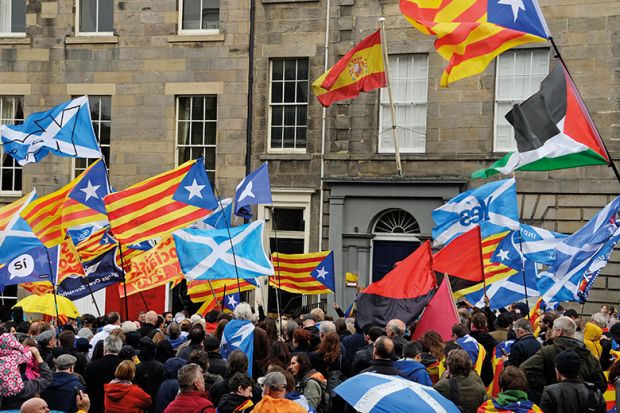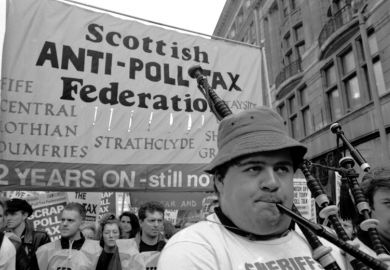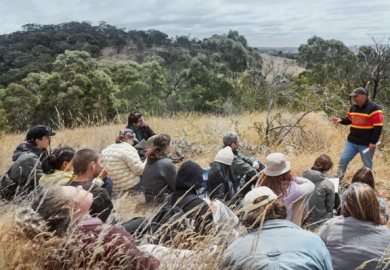In 2014, Scotland held a legitimate referendum, which asked if Scots wished to cede from the United Kingdom. Not only was this vote endorsed by Westminster, the Union Parliament provided the constitutional framework for it. In the end, 55 per cent of Scots rejected the opportunity for autonomy. The turnout was 85 per cent. By contrast, Catalonia held its own referendum, in October 2017. This ballot may have had moral authority, but it was illegal, because the Spanish constitution of 1978 expressly forbids such referendums unless called by the king (as the agent of the national president). Nevertheless, 90 per cent of residents voted to sever ties with Madrid. Against fierce Spanish state opposition, just 42 per cent of the electorate turned out. Eight members of Catalonia’s government, which had by then been suspended, were arrested. The president, Carles Puigdemont, went into exile.
The press and social media inevitably drew comparisons between Catalonia and Scotland. Unionists argued that, whatever Scotland’s grievances against Westminster, British state forces had never treated Scottish nationalists the way Madrid had manhandled its citizens in Catalonia. This is a seductive view for democratic unionists, but the comparison does not really stand up. Scotland issued no unilateral declaration of independence, and the 2014 result seemed to assure the union. Then, in 2016, came the referendum on the UK’s membership of the European Union. Almost 52 per cent voted to leave. Scotland and Northern Ireland voted to remain, Wales to leave. Suddenly, the future of the UK itself was back on the agenda.
As with all the themes discussed in J. H. Elliott’s fascinating and timely book, the larger context is always important. Post-2008 austerity plainly played a part in the Brexit vote, while Spain’s economic struggles also impacted on nationalism. The differences until now between Catalonia and Scotland have been mostly about larger contexts. The Northern Ireland Troubles and Basque separatism, for example, seem to have made Catalonian and Scottish nationalism less pronounced than they were. Where the UK state appeared to be a long-term, durable political union, certainly for Scotland and Wales anyway, Spain’s shorter periods of quiescence were still marked by grievances over comparative regional investment, taxes and other issues. Spain had eight constitutions between the early 19th and the late 20th centuries. After General Franco, further civil war remained a prospect and internal nationalisms grew.
Histories such as this one are clearly challenged by the essential problem of comparative history: that the explanatory force of similarity is threatened by the countervailing force of difference. However, this closely argued and detailed account reveals many striking alignments. Scotland’s and Catalonia’s stories begin, in the modern sense (and in terms of their inclusion within larger states), in the late 15th and early 16th centuries, with royal marriages. Ferdinand and Isabella’s union of 1469 united Aragon and Castile, shaping an emergent Spain. In 1503, James IV of Scotland wedded Margaret Tudor, whose grandson, James VI of Scotland, would in 1603 unify the crowns of England and Scotland.
Despite this, the differences between Scotland and Catalonia also evoke contrasts between Spain and the UK. Were it not for Brexit, comparisons might be weaker still. Divergence begins with two simple facts: Catalonia never was a state, whereas Scotland was. In practical terms, the wars of the long 18th century also foster a sense of difference. When Catalonia sought to benefit from Spain’s difficulties, in the early 18th century, its autonomy was stripped back. For Scotland, in this period, the response to the financial catastrophe of failed imperial venture capitalism (the Darien scheme of 1695) was union with England, in 1707. While two Jacobite risings (1715 and 1745-46) led to the proscription of many cultural and socio-legal features of Highland society, the subsequent growth of imperial opportunity and industrial and urban power saw Scotland ultimately prosper, especially in the 19th century.
Later European wars also highlight differences. Spain suffered occupation in the Napoleonic period; Scotland did not. Scotland’s impetus came from partnership – political, economic and military. It was Ireland, not the Highlands of Scotland, that witnessed the last great conspiracy with the French: the 1798 Rebellion. British imperialism and trade advantages, wrought by success against the French, created opportunities for Scotland. Elites benefited through political and business networks; Scotland’s own legal, educational and religious cultures remained. Scottish trade and diaspora connections suggested that the Scots were partners in Empire, not subordinates to England. Scots occupied central roles in the armed forces, commerce, government, medicine, and science and engineering. There can be little question that, in the epoch of industrial and imperial primacy, the UK union worked in ways that almost cannot be compared to Spain.
Catalonian nationalism was recharged in the 19th century, strengthened under the Republic in 1931 and then brutally repressed by Franco. Moreover, Spain spawned Franco, but centre-ground Conservatism prevailed in Britain. The most significant political change in the UK was the eclipsing of the Liberal Party by Labour and the transformative socialist vision of Clement Attlee’s first majority Labour government (1945-50). Scots, like the Welsh, were central to the post-1945 rise of Labour, so that the “Celtic fringe” was much more integrated than it would later appear. Yet declining staple industries and Margaret Thatcher’s disregard for Scottish sensibilities, as well as the country’s ailing economy and conflict over North Sea oil, fired nationalism. Trying out the poll tax north of the border was a specific disaster for unionism.
While the power of Labour in the UK and Franco in Spain had kept different lids on similar nationalist pressures, more recent times have seen developments that make Catalonia and Scotland look similar again. Spain’s constitution of 1978 made the post-Franco polity much more amenable to regional autonomy. Concessions were enacted from the late 1970s to 2006, whereupon, in 2010, the courts rolled back the most radical concessions. These developments were echoed in constitutional concessions in the UK since 1997, when Tony Blair became prime minister. Now, Scotland and Catalonia, like other European sub-state nations, have control over some taxes. Unionists generally wonder why such devolution is not enough. But in Britain we learn from Gladstonian Irish policy from the 1880s that “home rule” is more likely to strengthen than weaken internal nationalism. History repeats itself in Scotland and Catalonia. In Scotland, constitutional concessions have enabled what is in essence a single-issue nationalist party to become a party of competent governance. In contrast, traditional parties have lost ground in both places.
This book provides a fascinating and entangled story of historical contexts, the contemporary crisis of both the left and centre in Western politics, and the struggle to maintain, in the face of popular pressures, federations of ardent, sub-state nationalisms, as well as a transnational political federation, the EU. Perhaps the very legitimacy of traditional governance is under threat. In the UK, all this was framed by sustained industrial decline generally and the post-2008 austerity of coalition conservatism in particular. Spain’s economic condition was even worse. The Arab Spring, Libya’s collapse, bloody civil war in Syria, mass migration and refugee flight all come into the analytical frame. For a greater understanding of Scotland and Catalonia within a wider crisis of mainstream politics, this thought-provoking book is an ideal place to start.
Donald MacRaild is professor of British and Irish history at the University of Roehampton. He has published extensively on Irish and British migration. His book The English Diaspora in North America (with Tanja Bueltmann) was published in 2017 by Manchester University Press.
Scots and Catalans: Union and Disunion
By J. H. Elliott
Yale University Press
360pp, £20.00
ISBN 9780300234954
Published 10 July 2018
The author
Sir John Elliott, Regius professor emeritus of modern history at the University of Oxford, was born in Reading in 1930, where his father was a public school housemaster, and grew up in Surrey. He won an entrance scholarship to Eton, eventually specialising in French and German, but switched to history when he went up to Trinity College, Cambridge, in 1949.
The syllabus, he recalled, “introduced me to recent work on European history, including that of [Fernand] Braudel. But it was a tour of the Iberian peninsula at the end of my first year that opened my eyes to Spanish history and culture, and shaped my future career.” His major works in the field include The Revolt of the Catalans: A Study in the Decline of Spain, 1598–1640 (1963), Imperial Spain: 1469–1716 (1963), The Count-Duke Olivares: The Statesman in an Age of Decline (1986) and Spain, Europe and the Wider World, 1500–1800 (2009).
Asked about the value of the comparative approach that he has adopted in Scots and Catalans , Elliott explained: “Every country regards itself as exceptional. The great value of comparative history is its ability to break down the parochialism of so much work on national history by identifying, and then seeking to explain, the similarities as well as the differences between a nation’s past and that of other peoples.”
In this particular case, he was “concerned by the lack of perspective on the current separatist movements in Scotland and Catalonia, as if outbreaks of radical nationalism were a new phenomenon. I was also concerned by the selective use of history to highlight aspects of the past that could strengthen the secessionist cause. My book attempts to redress the balance.”
Matthew Reisz
POSTSCRIPT:
Print headline: Dual perspectives on breaking up
Register to continue
Why register?
- Registration is free and only takes a moment
- Once registered, you can read 3 articles a month
- Sign up for our newsletter
Subscribe
Or subscribe for unlimited access to:
- Unlimited access to news, views, insights & reviews
- Digital editions
- Digital access to THE’s university and college rankings analysis
Already registered or a current subscriber?








